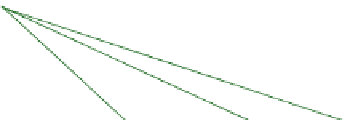Agriculture Reference
In-Depth Information
two point calibration along lines with varying slopes
max. rate
for early dressings
(BBCH 30 - BBCH 50)
min. rate
nitrogen uptake as sensed by reflectance index
one point calibration along lines with fixed slopes
max. rate
for early dressings
(BBCH 30 - BBCH 50)
min. rate
nitrogen uptake as sensed by reflectance index
reversed one point calibration with fixed slopes
max. rate
for late dressing
or quality-dressing
(beyond BBCH 50)
min. rate
nitrogen uptake as sensed by reflectance index
Fig. 9.37
Principal control-algorithms for site-specific nitrogen application based on reflectance
sensing and limiting rates. The course of the linear control lines is defined by the minimum rate,
the maximum rate and by the slope of the lines. The developmental stages for small cereals are
indicated in BBCH units. These are identical to EC units or Zadoks units (From Thiessen
2001
,
2002
, altered)
and then on another place for that the maximum rate seems adequate. At these two
points, the respective reflectance indices of both limiting rates are obtained for the
algorithm. The site-specific control should then logically take place along the line
that connects these two extreme points (Fig.
9.37
, top). A prerequisite for accuracy
with this
two point calibration concept
is that the farmer carefully selects the best
spots for the minimum- and maximum rate in the field.
In order to ease the calibration work for the farmer, a
one point calibration con-
cept
has been introduced and now has become a standard method for main crops
(Fig.
9.37
, center). With this concept, a
default slope
of the linear control line is in
the program of the algorithm. The default slope has been obtained from numerous
field experiments with the respective main crop. This allows to calibrate the sensor
by just recording the reflectance on one spot or on one short strip within the field and
assigning an estimated nitrogen rate to it. Within this spot or short strip, the farmer





















